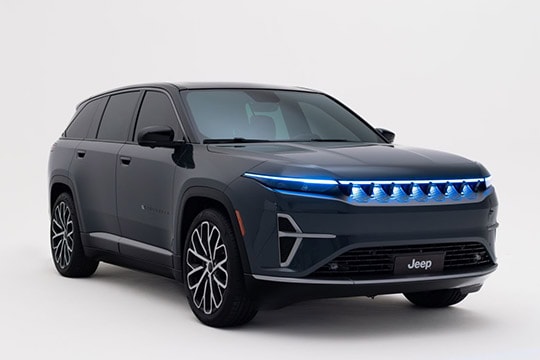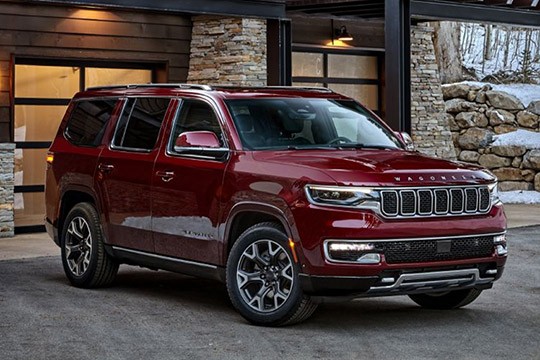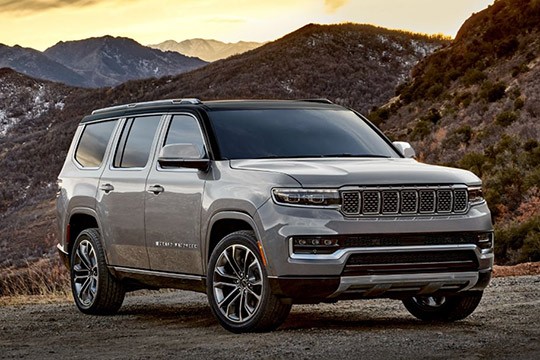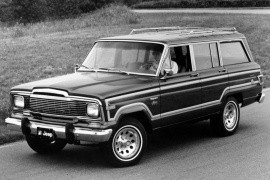JEEP Wagoneer Models/Series Timeline, Specifications & Photos
First production year: 1962
Engines: Electric, Mild hybrid, Gasoline
Body style: SUV (Sports Utility Vehicle)
Jeep finally entered the electric vehicle segment with the 2024 Wagoneer S, unveiled in the summer of 2024, an SUV that barely reminded customers that it belonged to the well-respected off-road oriented American brand.
When Jeep introduced the fourth generation of the Wagoneer (the WS) in 2022, it intended to transform the nameplate into a separate brand. But then it changed its mind and didn’t want to risk anything. After all, the first generation of this SUV appeared in 1962 when Claude King stormed the charts with the “Wolverton Mountain” hit. The subsequent two generations, the 1983 XJ and the 1993 ZJ, respectively, were more likely upscale versions of the Jeep Cherokee and Grand Cherokee. Then, in 2022, Jeep introduced the fourth generation of the Wagoneer, which was no longer built on a unibody structure, like the XJ and the ZJ, but on a body-on-frame one since it shared its chassis with the Ram 1500. However, the Wagoneer S had nothing in common with its predecessors. It was created on the STLA-Large platform and was an all-electric vehicle.
At the front, the most striking news was that there was no Jeep badge on the hood or anywhere else. Fortunately, it still featured a design theme that resembled the famous seven-slat grille just below the hood, although there wasn’t actually any gap there to let air in. The air intake was placed lower on the apron. Since it was an EV, it didn’t need that much of a cooling area. Jeep installed very slim headlights visually connected via a light stripe. In addition, the car had those seven slats illuminated from the top.
From the sides, the cabin was closer to the shape of a four-door coupe SUV rather than a regular 4x4 vehicle. Furthermore, the ascending waistline created the image of a sporty SUV, not one designed to tackle serious off-road trails. Moreover, the roofline was sloped down towards the back, cascading under a cantilevered rear wing. In addition, a lip spoiler was placed just below the rear window. Below that aerodynamic element, the car had its only Jeep badge stamped on the metallic part of the tailgate. The car also featured unique door handles, which were touch-sensitive and released the latches at the touch of a hand. Jeep also made the car lower to the ground than most of its other 4x4 stablemates. The automaker installed 19-inch light alloy wheels as standard, while the 2024 Jeep Wagoneer S Launch Edition featured a 20-inch set.
Jeep went on completely new ground when it made the Wagoneer S and created a high-tech cabin for the SUV. When fully optioned, there was a total of 41 inches of screens on the dashboard and center console. Fronting the driver was a digital instrument cluster, while the touchscreen for the Uconnect infotainment system had a 12.3-inch diagonal. Below it, the automaker installed another touch-sensitive display, which controlled the HVAC and the massaging functions. Furthermore, fronting the passenger was a 10.3-inch touchscreen. Strangely, there was no Jeep badge inside the vehicle. The driver fronted a hexagonal-shaped steering wheel that sported the Wagoneer badge. In the back, the SUV featured heated and ventilated outboard seats, which was uncommon for these types of vehicles. The 60/40 split-folding bench seat could dramatically increase the size of the trunk.
Jeep created the Wagoneer S for those who drove their SUVs within city limits or mostly around towns. It could still tackle some grass and snow-covered roads, but its preferred playground was the tarmac. With its 0.29 drag coefficient, it was the most aerodynamic Jeep in history, and the 600 hp (608 PS) confirmed the road-oriented character of the car. Furthermore, it could reach 60 mph (97 kph) from a standstill in 3.4 seconds, which was supercar territory. The automaker installed a 100 kWh battery pack using a 400-volt architecture, meaning it could charge from 20 to 80 percent in 23 minutes, while the estimated range was above 300 miles (482 km).
In 2021, Jeep unveiled a new generation of the Wagoneer, which, unlike its two predecessors, was no longer based on a unibody platform but on a body-on-frame structure.
The Wagoneer nameplate appeared on the market in late 1962 for the 1963 model year and led the way to the modern SUV with its family-oriented design. It was no longer a 4x4 vehicle built to endure rough terrains, even though it could, but to indulge families. The following two generations were made using the Jeep Cherokee XJ and the Grand Cherokee ZJ platforms, which looked more like trim levels rather than different vehicles. Then, in 2021, the American brand released the Wagoneer by Jeep. At that time, Stellantis tried to create an upscale brand for the industrial group, and that’s why the large-sized SUV didn’t sport the famous Jeep brand on it.
At the front, the car had a commanding look on the road, and despite not sporting the Jeep badge on it, it still featured the seven-slat grille. This was flanked by narrow LED headlights and was adorned by chromed trims and mesh design. Lower, on the bulky bumper, the car manufacturer installed another shiny decoration that underlined the fog lamps on the outer sides. But the Wagoneer had to be able to tackle some off-road areas, so the automaker offered it with an aluminum skid plate under the apron.
With a classical off-road-styled shape, the 2022 Jeep Wagoneer created a powerful image for the vehicle. Its platform, carried over from the Ram 1500, had a 123-inch (3.12-meter) wheelbase, which allowed the automaker to create generously sized doors. The design team created a window line that resembled the one from the original Wagoneer from the early ‘60s. Unlike that model, though, the fourth generation of this nameplate came with 20-inch alloy wheels fitted as standard, with an option for a 22-inch set. At the back, the automaker installed corner-mounted LED taillights extended over the tailgate and visually connected via a shiny black trim. Lower, the bumper sported the LEDs for the reversing and fog lamps and concealed the exhaust behind the valance.
However, the most significant step forward for the Wagoneer in the Stellantis’ evolution strategy was found inside the vehicle. The automaker worked tirelessly to create one of the most luxurious cabins in the brand’s history. Furthermore, it introduced all the technologies it had in its basket, and when it lacked something, it pushed its suppliers to create something new. As a result, the 2022 Jeep Wagoneer featured a completely digital instrument cluster that fronted the driver. In addition, a 12-inch touchscreen adorned the center stack between the center vents. Furthermore, there was an option for a side passenger screen, where those seated next to the driver could watch a movie, listen to their own music via Bluetooth headphones, or even monitor the rear seats via an interior video surveillance system. For the middle row, the automaker installed a bench seat for three and added the option for two 10.1-inch touchscreens. In the last row, the Wagoneer could accommodate three adult-sized passengers.
Under the hood, the 2022 Jeep Wagoneer had a 5.7-liter V8 gasoline engine and an electric motor for a total output of 392 PS (382 hp). The hybrid powerplant sent its oomph to the rear wheels or in all corners, depending on the options.
Jeep introduced the 2022 Grand Wagoneer as its most luxurious vehicle in the lineup, competing against the notorious Chevrolet Tahoe or Cadillac Escalade and dwarfed its European competitors made by Audi, BMW, and Mercedes-Benz.
When Willy’s Jeep introduced the first generation of the Wagoneer in late 1962 for the 1963 model year, the 4x4 vehicle market was dominated by rough and sturdy models. But the automaker took a different approach. It used its extensive knowledge in the off-road segment, combined it with the lessons learned from Kaiser, who owned the Jeep brand and then created something new. Many considered the first generation of the Wagoneer as the granddaddy of SUVs. It appeared almost a decade before the three-door Land Rover Range Rover. Unlike all the other off-road vehicles on the market, the 1963 Wagoneer was built for families. It could still tackle some off-road paths, but it was primarily built to satisfy the needs of a family. The following two generations were based on the Jeep Cherokee XJ and the Grand Cherokee ZJ, on unibody constructions. Surprisingly, the fourth generation of the Wagoneer and its more luxurious sibling, the Grand Wagoneer, re-introduced the body-on-frame construction, sharing its underpinnings with the well-known Ram 1500. However, its main competitors were those cars that could provide higher quality and luxury standards.
At the front, there were almost no differences between the Wagoneer and the Grand Wagoneer. They both sported LED headlights that flanked the notorious seven-slat grille. That was the only way that created a connection with the rest of the Jeep brand. On the lower side of the bumper, the big vehicle sported a set of LED foglamps that flanked a lower-mounted secondary grille, which improved cooling.
From its profile, there were little to no differences between the Wagoneer and the Grand Wagoneer. The car had the same massive stance with a flat front area and flared wheel arches in an off-road styling. Jeep’s design team created a window line that resembled the original Wagoneer from the early ‘60s. Jeep’s design team also added a two-tone black accent roof emphasizing the SUV’s luxurious character. On the lower side of the vehicle, the automaker installed standard retractable steps, which were designed in such a way that they didn’t affect the ground clearance. The automaker also added a set of aluminum wheels, with 20-inch in size as standard and 22-inch as an option.
Inside, the luxurious and high-tech cabin was a real feat for the Grand Wagoneer’s customers. Jeep installed acres of leather-upholstered areas, American satin walnut trims sporting the Grand Wagoneer nameplate, and up to eight available displays around the cabin. They totaled a massive 72 inches (1.83 m) in size. Fronting the driver was a digital instrument panel, while atop the center stack was the touchscreen for the infotainment system. Underneath it was another touch-sensitive display for the HVAC and massaging functions. Furthermore, a third touchscreen fronted the side passenger, where they could connect a pair of Bluetooth headphones, and they could also monitor those seated in the back via a local camera surveillance system. Both the front and the middle rows came with captain seats, while the third row featured a three-person bench seat good for adult-sized passengers.
Under the hood, the 2022 Jeep Grand Wagoneer had a 6.4-liter V8 paired with an eight-speed automatic transmission that sent all the power to all corners. For those looking for more adventurous driving experiences, the full-size SUV had a 25-degree approach angle, 24-degree departure angle, 22-degree breakover angle, and a ground clearance of 10 inches (25 cm). It also came fitted with standard air suspension, which greatly improved road behavior and comfort.
In 1962, Kaiser Jeep introduced the Wagoneer lineup as a replacement for the five-door Jeep Station Wagon model that had been in production since 1946, and the difference was massive.
Kaiser Jeep was the underdog in its fight against the Big Three: Detroit, Ford, Chrysler, and General Motors, and there was one area that it mastered: the production of off-road vehicles. Unfortunately for it, American customers were more fond of regular sedans and comfortable vehicles, such as the Chevrolet Impala, the Ford Galaxie, and the Chrysler 300. However, Jeep didn’t back down and created the Wagoneer lineup based on the same chassis as the Jeep Gladiator pickup truck. Furthermore, the U.S. was just recovering from the 1957-1958 recession. As a result, an expensive vehicle was out of the question. Somehow, though, the new model was successful, and in 1963, Kaiser added the Jeep name to the company’s credentials as the Kaiser Jeep Corporation. It was the moment that the Jeep became notorious not just for its rugged, go-anywhere vehicles but also for its comfortable, almost luxurious SUVs. In addition, this four-door 4x4 comfortable car broke covers eight years before Rover introduced the first generation of the two-door Range Rover.
The automaker introduced the Wagoneer in late 1962 for the 1963 model year, and the car’s front fascia had a particular shape that made it distinct. Its tall radiator grille resembled a Greek temple and featured eleven vertical chromed bars, not the seven-slat grille that was traditional for a Jeep. It was flanked by four round headlights, where the inner-mounted ones were smaller. Underneath them, the automaker placed the turn signals and a chromed bumper.
From its profile, the station wagon shape of the vehicle was attractive for customers looking for a family car but with some off-road capabilities. The squared wheel arches and the flat door panels adorned by two creases created the image of a rugged vehicle. Furthermore, the automaker placed the door mirrors above the front fenders for the 1963 model year, making it look different from other 4x4s from the same era. In the following year, though, Jeep moved them on the doors, just in front of the triangular swinging windows. The large glass area of the greenhouse and the stylish tilted forward D-pillars gave customers the impression that the Wagoneer was not built for construction sites or performing difficult jobs and that it could be an excellent daily driver. At the back, the automaker installed a roll-down rear window, which retracted into the flip-down tailgate. A set of red taillights adorned the edges of the quarter panels, while below them were the reversing lights.
Only when customers stepped inside the cabin did they realize that the Wagoneer was nowhere near any of the utilitarian vehicles of the main SUV’s competitors. Its vinyl-covered color dashboard, the bench seats for both rows, and the spacious cabin were suitable for most families. In addition, starting with the 1964 model year, the automaker introduced an AC unit on the options list. The driver fronted a two-spoke steering wheel that framed a small instrument cluster where the half-round speedometer dominated the panel above the odometer. In the back, the automaker installed a folding bench seat where three passengers could sit. Furthermore, the SUV started to be available with lap belts in 1964.
Under the hood, the Wagoneer began its journey with the help of a 3.8-liter inline-six fed by a double-barrel carburetor. It was mated with a three-speed gearbox, while an automatic gearbox was on the options list. All versions came with a 4x4 system and independent front suspension, which made it feel like a sedan, not an SUV. But still, for going off-road, Jeep installed manual locking hubs, a two-speed transfer box, and a rigid axle in the rear. Later, a 327 V8 became available.



